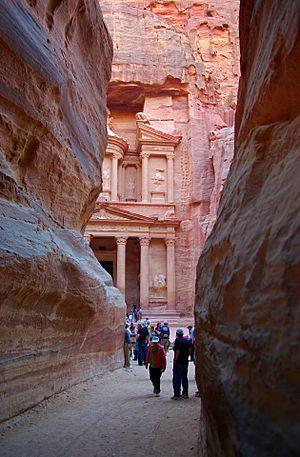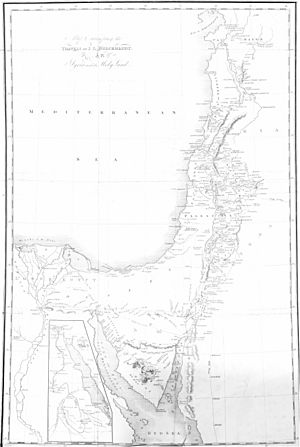Johann Ludwig Burckhardt facts for kids
Quick facts for kids
Johann Ludwig Burckhardt
|
|
|---|---|
 |
|
| Born | 24 November 1784 |
| Died | 15 October 1817 (aged 32) |
| Nationality | Swiss |
| Occupation | traveller, geographer, orientalist |
Johann Ludwig Burckhardt (born November 24, 1784 – died October 15, 1817) was a Swiss explorer and geographer. He was also known as John Lewis or Jean Louis. During his travels in Arabia, he used the name Sheikh Ibrahim Ibn Abdallah to keep his true identity a secret.
Burckhardt is famous for finding the ancient city of Petra in Jordan again. This city was once the capital of the Nabataean Kingdom.
Contents
Early Life and Adventures
Johann Ludwig Burckhardt was born in Lausanne, Switzerland, in 1784. His family was wealthy and involved in silk trading in Basel. He studied at universities in Leipzig and Göttingen.
In 1806, he went to England. He wanted to work for the African Association. His mission was to explore the Niger River in Africa. To get ready, he studied Arabic, science, and medicine at Cambridge University. He also started wearing Arabian clothes.
In 1809, he traveled to Aleppo, Syria. He wanted to improve his Arabic and learn about Muslim customs. On his way, he heard that another explorer, Ulrich Jasper Seetzen, had gone missing while looking for Petra.
While in Syria, Burckhardt pretended to be a Muslim named Sheikh Ibrahim Ibn Abdallah. This helped him hide his European identity. He studied local languages and old historical sites. He even found some ancient writings called Luwian hieroglyphs.
He faced some challenges, like being robbed. But after more than two years, he felt ready to travel safely. He made three short trips around Syria, Lebanon, Palestine, and Transjordan. He traveled as a poor Arab, sleeping on the ground. These trips helped him test his disguise.
In early 1812, he left Aleppo for Cairo. On his journey, he was robbed again near Kerak. Despite this, he found a new guide and continued his journey south.
Discovering Petra and Later Travels

As Burckhardt traveled towards Aqaba, he heard stories about ancient ruins in a narrow valley. People said these ruins were near the biblical tomb of Aaron, Moses's brother. He remembered hearing about a lost city called Petra.
On August 22, 1812, he convinced his guide to take him to the tomb. He said he wanted to sacrifice a goat there. This led him through a hidden valley. There, he became the first modern European to see the amazing ancient city of Petra.
He wrote about his discovery:
I really wanted to visit Wady Mousa, because people spoke wonderfully about its old buildings... I hired a guide to take me to Aaron's tomb... I was alone in a desert where no traveler had ever been seen before…
An amazing tomb carved into the rock appeared. It was so beautiful and impressive after walking through such a dark, narrow path. The local people called it Pharaoh's castle. But it was more likely a prince's tomb. This city must have been very rich to build such monuments for its rulers...
It seems very likely that the ruins in Wady Mousa are those of ancient Petra. I am sure there is no other important ruin between the Dead Sea and the Red Sea that could be this city.
— Johann Burckhardt, Travels in Syria and the Holy Land, pages 418–431
He couldn't stay long or take many notes. He was afraid people would discover he was a European looking for treasure. He continued his journey and arrived in Cairo on September 4, 1812.
Burckhardt spent four months in Cairo. Since there were no caravans going west across the Sahara Desert, he decided to travel up the Nile River. He explored Upper Egypt and Nubia. He hoped the information he gathered would help him later.
In January 1813, he traveled by donkey up the Nile. He aimed to reach Dongola in what is now Sudan. He was stopped by unfriendly people before reaching his goal. On his way back north, he found the sand-covered ruins of the Great Temple of Ramesses II at Abu Simbel in March 1813. He tried to dig out the entrance but couldn't. He later told his friend Giovanni Battista Belzoni about it. Belzoni returned in 1817 and successfully excavated the temple.
Burckhardt continued his travels. He went to Shendi near the Pyramids of Meroë. From there, he traveled to the Red Sea. He decided to make a pilgrimage to Mecca. This would make him seem even more like a Muslim, which was important for his planned trip to Timbuktu.
Pilgrimage to Mecca and Final Years
After crossing the Red Sea, he arrived in Jeddah on July 18, 1814. He became sick there. He proved he was a Muslim and was allowed to travel to Mecca. He spent several months in Mecca, performing the Hajj rituals. It was very rare for a European to do this.
He wrote detailed notes about the city and its people. His journals were very helpful to another explorer, Richard Francis Burton, who also visited Mecca later. Burckhardt then visited Medina, where he got sick again and spent three months recovering.
He left Arabia and traveled across the Sinai peninsula to Cairo. He arrived on June 24, 1815, feeling very tired.
Burckhardt spent the last two years of his life in Cairo. He worked on his journals and waited for a caravan to take him across the Sahara to Timbuktu. He visited Alexandria and Mount Sinai, where he saw Saint Catherine's Monastery.
In Cairo, he met Giovanni Belzoni and introduced him to Henry Salt, the British consul in Egypt. Salt hired Belzoni to move a huge statue of Ramesses II from Thebes to the British Museum.
Johann Ludwig Burckhardt became sick again with dysentery and died in Cairo on October 15, 1817. He never made it to the Niger River. He was buried as a Muslim, and his tombstone has the name he used on his travels.
He had sent his journals, notes, and letters to England over time, so most of his discoveries were saved. He also gave his collection of 800 books of Middle Eastern writings to the University of Cambridge library.
See also
 In Spanish: Johann Ludwig Burckhardt para niños
In Spanish: Johann Ludwig Burckhardt para niños


